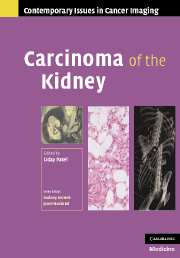Book contents
- Frontmatter
- Contents
- Contributors
- Series foreword
- Preface to Carcinoma of the Kidney
- 1 Renal cell cancer: overview and immunochemotherapy
- 2 Pathology of adult renal parenchymal cancers
- 3 Familial and inherited renal cancers
- 4 Radiological diagnosis of renal cancer
- 5 Staging of renal cancer
- 6 The case for biopsy in the modern management of renal cancer
- 7 Imaging characteristics of unusual renal cancers
- 8 Surgery for renal cancer: current status
- 9 Ablation of renal cancer
- 10 Post-treatment surveillance of renal cancer
- 11 Imaging for nephron-sparing procedures
- Index
- Plate Section
- References
10 - Post-treatment surveillance of renal cancer
Published online by Cambridge University Press: 08 August 2009
- Frontmatter
- Contents
- Contributors
- Series foreword
- Preface to Carcinoma of the Kidney
- 1 Renal cell cancer: overview and immunochemotherapy
- 2 Pathology of adult renal parenchymal cancers
- 3 Familial and inherited renal cancers
- 4 Radiological diagnosis of renal cancer
- 5 Staging of renal cancer
- 6 The case for biopsy in the modern management of renal cancer
- 7 Imaging characteristics of unusual renal cancers
- 8 Surgery for renal cancer: current status
- 9 Ablation of renal cancer
- 10 Post-treatment surveillance of renal cancer
- 11 Imaging for nephron-sparing procedures
- Index
- Plate Section
- References
Summary
Introduction
If salvage surgery or immunotherapy is to be offered in a timely fashion for recurrent renal cancer, surveillance after treatment is important to ensure early detection of recurrence, although improved survival with such an approach has yet to be proven. Suggested surveillance protocols have been published to follow patients with treated renal cell carcinoma (RCC). However, in practice, there is little consensus on appropriate surveillance protocols amongst practicing urologists and a recent study documented that published guidelines are often not used with any consistency. This chapter is a review of the clinical features of recurrent disease and how they influence chosen surveillance methods and protocols.
Likelihood of recurrent renal cancer
Approximately a third of the patients who present with localized RCC will develop a local or distant recurrence after therapy. Higher T-stage tumors are associated with increased risk of tumor recurrence. Lam et al. recently reported that overall distant recurrence rate at 5 years after surgical resection was 27.6% for localized disease and 64% for node positive disease. Five-year recurrence-free rate after nephrectomy in patients stratified into a low risk group was 90.4%, intermediate risk group was 61.8%, and high risk group was 41.9%. Median time to recurrence was 28.9 months, 17.8 months, and 9.5 months in the low risk, intermediate risk, and high risk groups respectively.
- Type
- Chapter
- Information
- Carcinoma of the Kidney , pp. 185 - 202Publisher: Cambridge University PressPrint publication year: 2007
References
- 1
- Cited by



